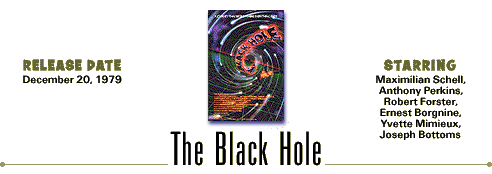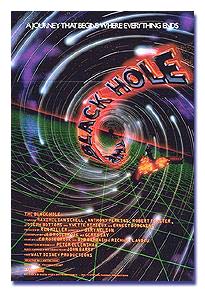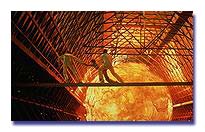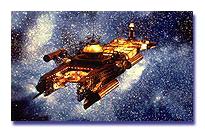 |
 |
 |
 he explorer craft U.S.S. Palomino is returning to
Earth after a fruitless 18-month search for extra-terrestrial life
when the crew comes upon a supposedly lost ship, the magnificent
U.S.S. Cygnus, hovering near a black hole. The ship is controlled
by Dr. Hans Reinhardt and his monstrous robot companion,
Maximillian. But the initial wonderment and awe the Palomino crew
feel for the ship and its resistance to the power of the black hole
turn to horror as they uncover Reinhardt's plans, which involve
turning his former crew into robots and flying through the hole. As
they try to escape, a meteorite shower damages the ship, and the
survivors hang on as they are plunged into the most powerful force
in the universe, heading toward the blinding light that holds
whatever eternity awaits them. he explorer craft U.S.S. Palomino is returning to
Earth after a fruitless 18-month search for extra-terrestrial life
when the crew comes upon a supposedly lost ship, the magnificent
U.S.S. Cygnus, hovering near a black hole. The ship is controlled
by Dr. Hans Reinhardt and his monstrous robot companion,
Maximillian. But the initial wonderment and awe the Palomino crew
feel for the ship and its resistance to the power of the black hole
turn to horror as they uncover Reinhardt's plans, which involve
turning his former crew into robots and flying through the hole. As
they try to escape, a meteorite shower damages the ship, and the
survivors hang on as they are plunged into the most powerful force
in the universe, heading toward the blinding light that holds
whatever eternity awaits them. |
|
 |

The film was five years in development and 14 months in production,
and cost $20 million. It failed to recoup its terrific cost, but
wowed audiences with the dazzling special effects created by
A.C.E.S. (Automatic Camera Effects Systems). All the sound stages
at the Disney Studio were occupied by the production. Nearly 14
months of simultaneous and post-production filming and processing
were required by the studio's photographic process laboratory and
special effects departments. In some scenes, as many as 12
different photo processes were used simultaneously on the screen.
Four Academy Award® winners supervised the special effects:
Peter Ellenshaw, production designer and director of special
effects; Eustace Lycett and Art Cruickshank, special photographic
effects; and Danny Lee, special visual effects. The film was
nominated for Academy Awards® for Cinematography (Frank
Phillips) and Visual Effects. The film's original producer, Winston
Hibler, died during production. |
|
 |

Premiered in London on December 18, 1979. Directed by Gary Nelson.
First film made by the Disney Studio to receive a PG rating. 98
min. Released on video in 1980 and 1983. |
|
 |
 |
|
|
 |
 |
 |
|
|
 |
|
 |